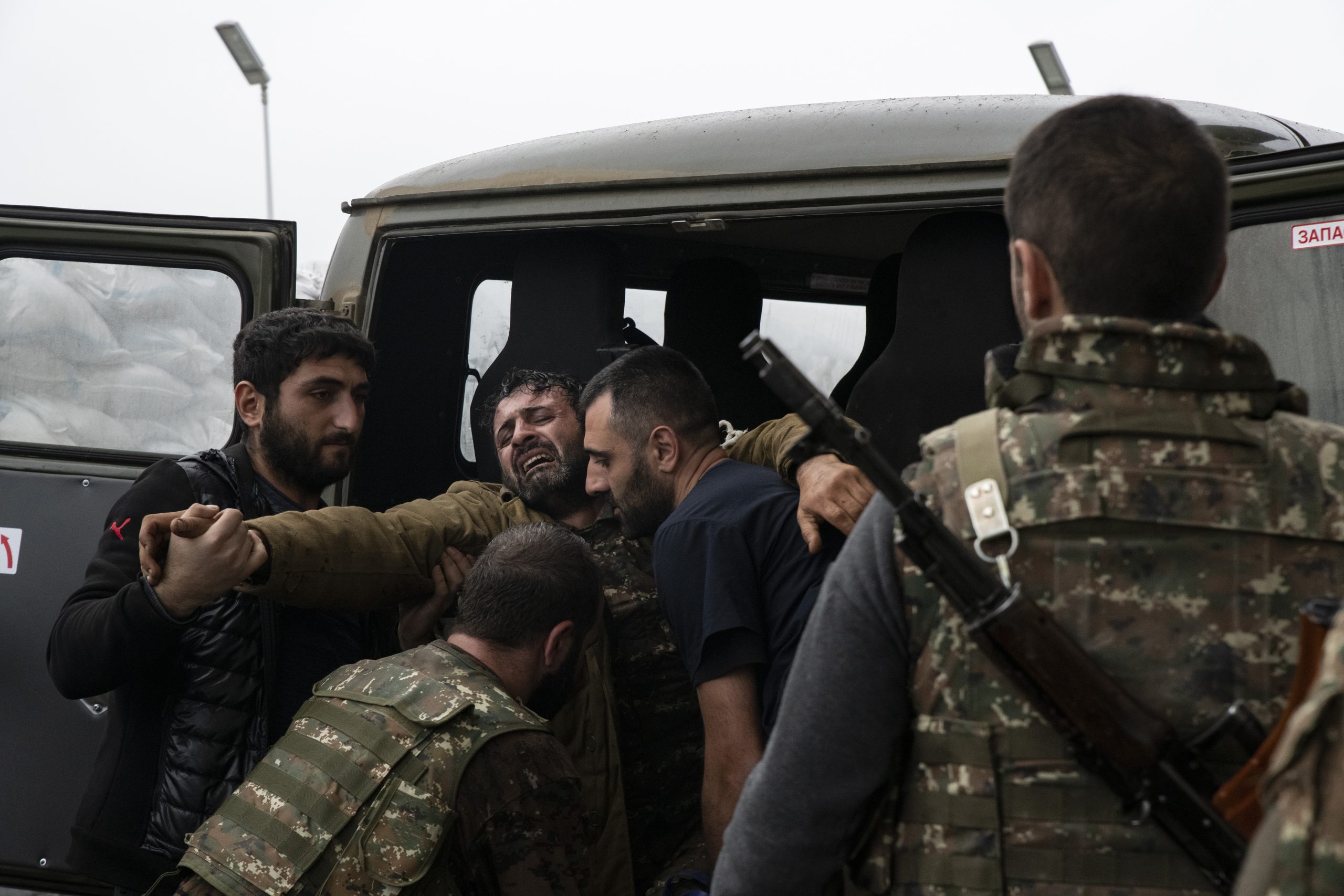
The de-facto Armenian authorities of Nagorno-Karabakh announced on September 28 the dismantling of all institutions by January, marking the end of the enclave, which dates back to the beginning of the Soviet period.
The Armenian government of the region, which it calls Artsakh, has dissolved, its army surrendered, and one of its former leaders was arrested, all in the space of a few days. It is an ignominious end to a 35-year-old statelet.
This also marks an end to a tragic story of one of the most brutal territorial and ethnic conflicts in what was once the Soviet Union, and ushers in an interesting precedent where a post-Soviet country successfully reconquered its lost territories.
Azerbaijan’s victory changes the ethnic composition on the ground. At the time of publication, more than 50% of Karabakh’s Armenian population of 120,000 had fled the region. Many more are expected to go. This is not population expulsion at the point of a bayonet, but that may be because Azerbaijan doesn’t need to. The months-long Azeri siege of the Armenian community, denying them food and medicine, made clear that its intentions were not friendly.
How did all this come about?
Nagorno-Karabakh is a mountainous area in the South Caucasus with a historically mixed population. Throughout the 20th century, the region evolved into a mostly Armenian-populated area. Armenians and Azeris clashed after the end of the Romanov Empire, but with the Soviets, relative peace was established, though the roots of future conflict were seeded by placing the Nagorno-Karabakh Autonomous Oblast within Azerbaijan, with no land connection to Armenia.
Over time, tensions grew. The process accelerated in the late 1980s, as the Soviet Union started to disintegrate. The regional parliament of Nagorno-Karabakh voted to become part of Armenia, although the decision was not recognized by the central Soviet authorities or Azerbaijan.
With Soviet imperial power fading, hostilities erupted in 1988 and lasted six years. Armenia was the winner, and as a result, Nagorno-Karabakh, with its surrounding territories, became a de facto independent republic, heavily backed by Armenia, but internationally recognized as part of Azerbaijan.
Get the Latest
Sign up to receive regular emails and stay informed about CEPA’s work.
For decades, there were multiple efforts to negotiate. One such was mediated by the Organization for Security and Co-operation in Europe (OSCE) Minsk Group (co-chaired by Russia, the United States, and France), but there was no significant progress.
As talks floundered, there were intermittent political and military escalations. Clashes occurred along the line of contact and claimed numerous lives on both sides. In 2016, for example, Azerbaijan managed to occupy hundreds of hectares of land in a short campaign often seen as a precursor to the Second War of 2020.
In late September of that year, Azerbaijan launched a short and successful campaign to reclaim the area, using foreign-supplied technology, including drones. More than 5,000 troops on both sides were killed in just six weeks of hostilities. The Kremlin — which rejected Armenian pleas for military aid — brokered a temporary ceasefire on November 10, which handed most of the seven regions around Karabakh itself and parts of the separatist region, including the city of Shusha, to Azerbaijan. In a major Russian victory, a key element of the deal was the dispatch of a 2,000-strong peacekeeping force to the truncated region.
While the 2020 ceasefire agreement brought an end to active hostilities, the fundamental disagreements between Armenia and Azerbaijan regarding the region’s status remained. The international community continued to monitor the situation, hoping for a comprehensive and lasting resolution. As in the past, these efforts made barely any difference.
And yet things had changed in the three decades since the first ceasefire. Azerbaijan had built a war-winning military; it had reasonable relations with Armenia’s long-standing friends, and it had become a major energy supplier to the European Union (EU) after the Kremlin’s attempt to annex large parts of Ukraine. The Azeri president, Ilham Aliyev, may have felt there was no better time to strike.
The result of all this is far from clear, however. There are multiple questions about what the new power balance will mean for the region, and especially Iran. The latter has enjoyed close ties to Armenia and was uneasy that the 2020 war irreversibly tilted the balance toward Azerbaijan. This caused a re-think in Tehran, which concluded it should use a mixture of military deterrence (holding military exercises) and diplomatic pressure against Azerbaijan.
Russia, another of the big three powers bordering the South Caucasus (along with Iran and Turkey), has also markedly changed its approach. Its tolerance of Azerbaijan’s use of force may partly be linked to its need to access Iran as a part of the International North-South Transport Corridor. The route runs through Azerbaijan. It may also be because its forces in the region have been stripped to the bone to reinforce its war of aggression in Ukraine.
But there is a personal element too. Putin’s animus toward Armenia’s prime minister, Nikol Pashinyan, who came to power after the revolution in 2018, is deep-seated. There are many reasons for this, but Pashinyan’s attacks on Russia’s refusal to assist and his questioning of the Kremlin-led Collective Security Treaty Organization (CSTO), along with exercises with US forces, have infuriated Russia. So too, has the decision to join the International Criminal Court (ICC), which has a warrant out on Putin.
Yet it is doubtful that Russia will simply allow Azerbaijan to regain its territories in the hope of having a more Russia-leaning leadership. Perhaps there is a wider calculus at play: Moscow may be extracting concessions from Baku which might include membership of CSTO or its Eurasian Economic Union (EEU).
The real problem now — apart from the absolute fury of many Armenians — is that there’s another issue between the two rival states with almost the same explosive potential.
The presidents of Turkey and Azerbaijan met in the area of Nakhchivan on September 26. This is part of Azerbaijan physically separated from the motherland by Armenian territory. It was clear from the words used by Aliyev when speaking with Turkish President Recep Tayyip Erdoğan that he is now seeking a “peace corridor” between the two parts of Azerbaijan. This has previously been referred to by Iran as a casus belli.
The losers of the Nagorno-Karabakh dispute are now apparent. Clearly, Armenia has been defeated; it is in no position to challenge Azerbaijan’s gains and is deeply divided internally and militarily inferior. Whatever Russia says, it has been exposed as an unreliable ally and as a spectator rather than the key power in the region. And the US and EU have been revealed as the authors of strong statements, but not much else.
The winners are Azerbaijan and its closest ally, Turkey. What they decide will determine whether there is peace or more war in the South Caucasus.
Emil Avdaliani is a professor at European University and the Director of Middle East Studies at the Georgian think-tank, Geocase.
Europe’s Edge is CEPA’s online journal covering critical topics on the foreign policy docket across Europe and North America. All opinions are those of the author and do not necessarily represent the position or views of the institutions they represent or the Center for European Policy Analysis.
Europe’s Edge
CEPA’s online journal covering critical topics on the foreign policy docket across Europe and North America.
